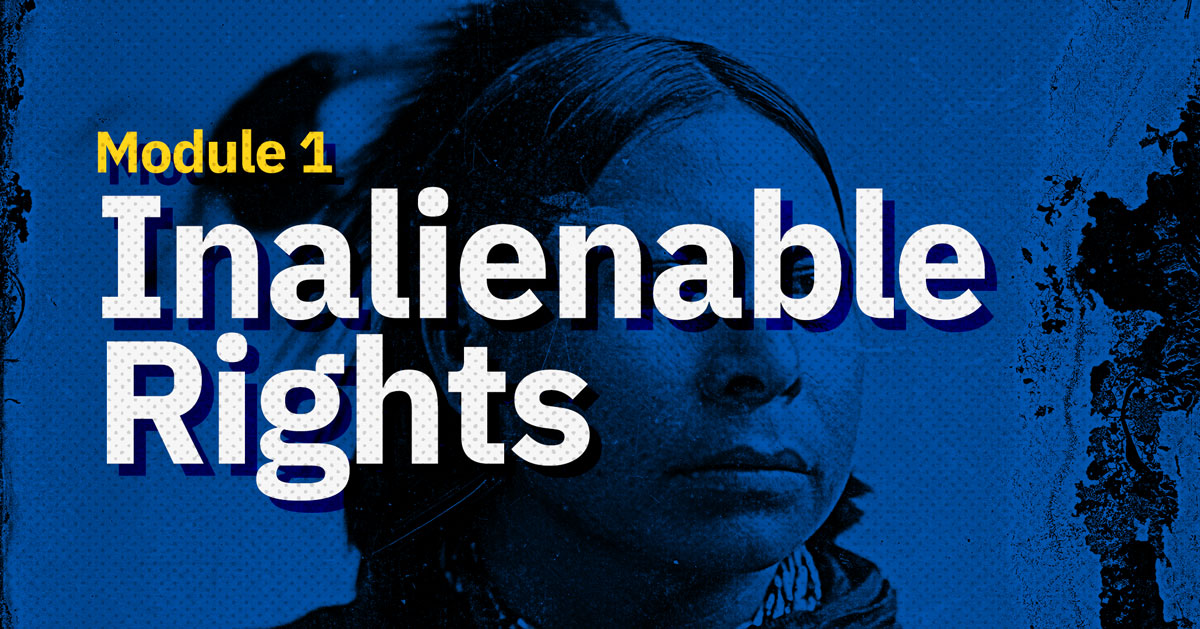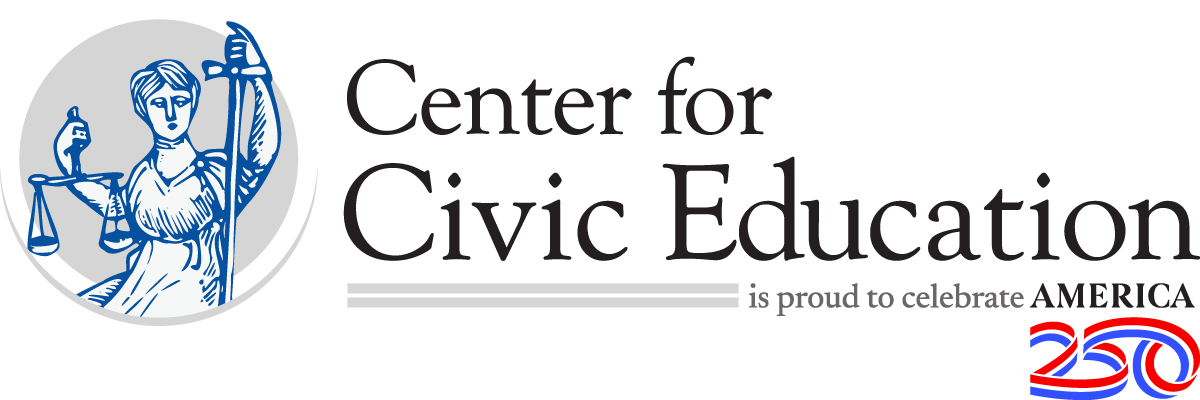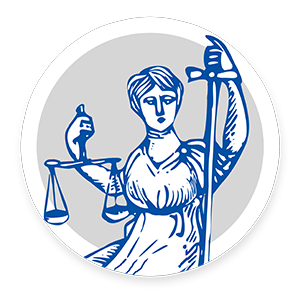
Module 1: Inalienable Rights
In this lesson, students will explore the inalienable rights of both rural and Indigenous communities. Students will examine if rights have been protected or denied to these groups. Indigenous communities in the United States have a varied and complex history in the United States. At different points throughout this history, these communities have been shaped by both recognition and denial of their inalienable rights.
Lesson Plan: Day 1
- Welcome students to social studies.
- Ask students, “What does happiness mean to you?”
- Have students turn to trio teams and share their answers. Ask them to find one similarity and one difference between their answers.
- Invite students to share what happiness means to them or what they noticed about their partners’ perspective.
- Ask students, “How does being happy connect to having freedom and making choices in your life?”
- Have students share their responses either in trio teams or as a whole group.
- Tell students we will explore whether the United States has been able to deliver on its promise of happiness as well as ensuring life and liberty for all people.
- Introduce the compelling question: “Has the United States made good on its promises of life, liberty, and pursuit of happiness for all?”
- Ask students whether the phrase “life, liberty, and the pursuit of happiness” sounds familiar. Ask students whether they recognize where this phrase comes from.
- Note: The final version of the Declaration uses the word unalienable. Some earlier drafts used the word inalienable. It is believed that Jefferson’s draft used inalienable, but it was then changed by the printer to unalienable before it was printed. The two words mean the same thing. Since the 1830s, the version using inalienable has been favored.
- Provide the definition of inalienable rights, and highlight that the inalienable rights stated in the Declaration of Independence are life, liberty, and the pursuit of happiness.
- Students may need further support with liberty. Liberty is the state of being free to make your own choices without physical restraint. Yet enjoying liberty means you must also govern yourself in a way that respects the equal rights of others.
- Allow students time to make a prediction about the compelling question as well as offer their own supporting questions.
Universal Design for Learning (UDL)
- Provide visuals along with the question, “what does happiness mean to you?” to help connect ideas.
- Utilize this video to support the comprehension of the definition of liberty.
- Offer both written and audio options for such terms as inalienable rights, life, liberty, and pursuit of happiness.
- Show this Declaration of Independence video to support student understanding of inalienable rights.
Multilingual Learners (ML)
Social-Emotional Learning (SEL)
Civic Skills & Dispositions
Extending Learning
- Inform students that they will be analyzing a primary-source document in teams to investigate the promises of life, liberty, and pursuit of happiness.
- Use the vocabulary slide deck for Day 1 (slide 34) as a daily warm-up by flashing 3–5 words you feel your students should have a firm understanding of for Day 1, having students turn and talk, use the word in a sentence, or draw a quick symbol to represent it.
- Display the definition of Indigenous peoples to the class and answer any questions that arise.
- Indigenous peoples are inhabitants of a place since ancient times with distinct social and cultural groups who share collective ancestral ties to the lands and natural resources where they live, occupy, or from which they have been displaced, often by colonization.
- Provide general facts about Indigenous communities to students.
- Pause to clarify or expand on any points students find interesting.
- Play the video, 6 Misconceptions About Native American People. As students watch, they should listen for connections between the misconceptions and the facts and perspectives shared in the video.
- Play the video a second time to ensure comprehension as needed.
- Ask students what surprised them about the misconceptions discussed in the video.
- Inform students: “When we talk about Indigenous peoples of America, it is important that we recognize this is a diverse group. While we often think of Native Americans from the continental United States as Indigenous peoples, it is important to recognize that Native Alaskans and Native Hawai'ians are also indigenous to this nation. Each group has its own unique history, culture, and traditions. Let’s keep this in mind today as we continue our learning today.”
- Inform students that they will be looking at inalienable rights through the eyes of Indigenous communities. Ask students:
- How might misconceptions about Indigenous peoples have influenced how the government and society addressed their rights to life, liberty, and the pursuit of happiness?
- Possible responses may include the following words: disenfranchised, denied citizenship, and removal from ancestral lands.
- How might misconceptions about Indigenous peoples have influenced how the government and society addressed their rights to life, liberty, and the pursuit of happiness?
- Provide the definition of proclamation to the class and answer any questions that arise.
- A proclamation is a public or official announcement that deals with a matter of great importance.
- Tell students that they will be analyzing a proclamation that addresses Indigenous communities and their rights.
- Explain that the purpose of analyzing the proclamation is to understand how inalienable rights are recognized, protected, or not protected for Indigenous communities in the United States.
- Using your routine strategy for assigning groups, divide students into groups of four. Each group will be assigned to one paragraph of the proclamation noted as Exhibit A, B, C, or D.
- Distribute Proclamation on Indigenous Peoples’ Day and mention that the proclamation is an example of how the national government acknowledges Indigenous communities. As a class, review the Annotation Station strategies to ensure students understand expectations:
- ❍ Circle words you do not know, and take a moment to find the definition.
- Highlight in YELLOW phrases that confuse you. Use context clues to figure out their meaning.
- Highlight in RED any references to the historical treatment of Indigenous people.
- Highlight in GREEN any references to present and future acknowledgement of Indigenous people.
- ✩ Star the phrase or line that you find most important.
- Instruct students to work collaboratively to read and annotate their assigned paragraph. Students will work as a team to restate the proclamation paragraph in their own words and should be prepared to share it with the class.
- Circulate around the room, encouraging each group, observing progress, and redirecting as needed.
- Direct students to discuss their annotations with their section of the text.
- Provide sentence starters to support discussion:
- “I think this part of the proclamation means …”
- “This phase supports the idea that …”
- “I am unsure about this part, but it might mean …”
- Provide sentence starters to support discussion:
- Guide groups to answer the three questions at the bottom of the Annotation Station:
- What we think this primary source is saying …
- Does this proclamation support or protect the inalienable rights of Indigenous Americans?
- We think this proclamation DOES or DOES NOT support inalienable rights of Indigenous People because …
- Connect student findings to essential question:
- Based on your group’s finding, how does the proclamation address the ideas of life, liberty, and the pursuit of happiness?
- After all student groups have had a chance to learn about their assigned portion of the primary source reading, bring the class back together for a brief whole-group debrief. Students will share what their group learned, and an opportunity for clarifying questions will be provided.
Universal Design for Learning (UDL)
- Provide a list of vocabulary terms, like proclamation and Indigenous peoples.
- Allow students to choose between annotating digitally or on paper to accommodate different preferences.
- Demonstrate how to annotate by walking through a sample sentence from the proclamation as a class.
- Offer an auditory recording of the proclamation for auditory learners.
- Exhibit B on Proclamation on Indigenous Peoples’ Day could be used to support emerging readers.
- Assign roles like note taker, time keeper, etc., for collaboration.
Multilingual Learners (ML)
Social-Emotional Learning (SEL)
Civic Skills & Dispositions
Extending Learning
- Reconvene as a whole class and tell students that they will now use their rephrased paragraph to deliver their own Proclamation on Indigenous Peoples’ Day.
- Play a brief video clip of this or any White House press conference. All are in the public domain on the White House YouTube channel. Note: teachers can find press conferences that are relevant to issues in their state if desired.
- Briefly support students’ observations about the video as they lift up any characteristics or processes that they notice.
- Students will share their segment of the proclamation in their own words, going in numerical order.
- While listening to other teams deliver sections of the proclamation, students will use the Press Pass to take notes on each section. Review this organizer to ensure students understand expectations.
- Simulate a brief in-class press conference where students present the proclamation and audience members take on the role of the press and ask questions.
Universal Design for Learning (UDL)
- If possible, turn on closed captioning for video clips.
- Model to students how to ask questions in a press conference before beginning the simulation.
Multilingual Learners (ML)
Social-Emotional Learning (SEL)
Civic Skills & Dispositions
Extending Learning
- Introduce the Indigenous Inalienable Rights video. Explain that it features an academic scholar answering the question, “Think about your inalienable rights of life, liberty, and the pursuit of happiness. What does that look like in your community? Does everyone enjoy these same rights, or have individuals or certain groups been denied them? What impact does this have on your lives and your community?”
- Play the Indigenous Inalienable Rights video, and as students watch, they should listen for how the speaker’s points relate their own own experiences about fairness and opportunity.
- Play the video again to ensure comprehension. Ask students to think about how they would answer the same question about their own community as they listen to the scholar.
- Designate four areas of the learning space to represent the following responses:
- Strongly agree
- Agree
- Disagree
- Strongly disagree
- Read the first question: “Everyone in my community enjoys the same rights to life, liberty, and the pursuit of happiness.”
- Students will vote with their feet and choose a corner that best represents their opinion.
- Once all students have chosen a corner, students will discuss the question with others who chose the same corner.
- After four minutes, ask one to two students from each corner to share their group’s discussion with the class. Allow students to move corners.
- Read the next question: “Some individuals or groups in your community face barriers that limit their ability to fully access opportunities and freedoms.”
- Repeat the four-corner process: students choose a corner, discuss, and share out again. Corners should have the same labels.
- After the four-corner activity, as a class, students reflect and share out on the question, “What do different opinions about rights and freedoms tell us about how they are experienced in our country?”
- Play the Student-Created Video and as students watch, they should listen for examples of inalienable rights that the students provided.
- Play the video a second time to ensure comprehension.
- Facilitate a brief class discussion encouraging students to think about land and water rights in their own community and answer the following:
- What do inalienable rights look like in your community?
- Does everyone enjoy inalienable rights (life, liberty and the pursuit of happiness) or have the rights of individuals or certain groups been denied?
- What impact does this have on your lives and your community?
- Thank students for participating in this civic conversation.
Universal Design for Learning (UDL)
- Utilize closed captioning when viewing videos, or access the Show Transcript feature (when viewing on YouTube) if needed.
- Show each statement during the four-corner activity. Allow students time to reflect before sharing responses with the group.
- Use posters or slides to display the four-corner categories for students to refer to during the four-corner activity.
Multilingual Learners (ML)
Social-Emotional Learning (SEL)
Civic Skills & Dispositions
Extending Learning
- Instruct students to complete the Exit Ticket.
- Provide the following sentence starter:
- “I think the United States has made good on its promises of life, liberty, and the pursuit of happiness to Indigenous communities because …” OR
- “I think the United States has NOT made good on its promises of life, liberty, and the pursuit of happiness to Indigenous communities because …”
Universal Design for Learning (UDL)
- Offer students the choice to record their responses to the Exit Ticket.
- Provide sufficient wait time after presenting the Exit Ticket so all students can process and respond.
Multilingual Learners (ML)
Social-Emotional Learning (SEL)
Civic Skills & Dispositions
Extending Learning






